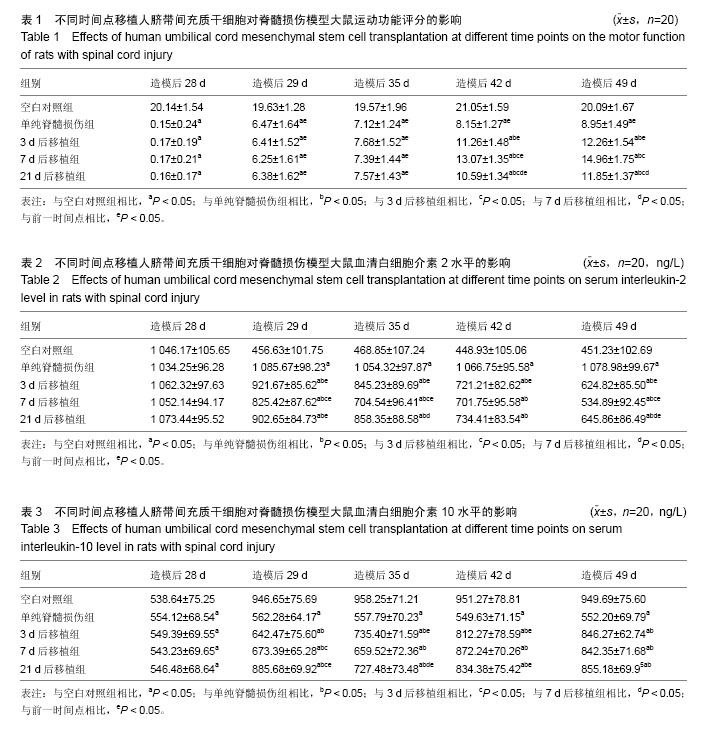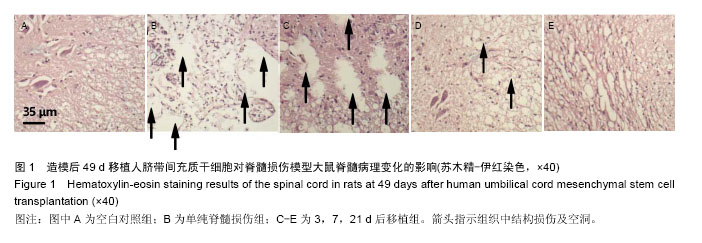| [1] 孙海伟,陆士奇,陈庆梅,等.不同来源干细胞移植治疗创伤性脊髓损伤的免疫反应[J].江苏医药,2015,2(16): 1867- 1870.
[2] 李波.脊柱手术并发脊髓不完全损伤10例临床分析[J].现代仪器与医疗,2014,2(6):52-54.
[3] Han YF, Sun TJ, Han YQ, et al. Preparation of microencapsulated VEGF gene-modified human umbilical cord mesenchymal stem cells and in vitro culture. Eur Rev Med Pharmacol Sci. 2013;17(2): 217-223.
[4] 陆士奇,孙海伟,刘励军,等.脐带源与骨髓源干细胞移植治疗大鼠脊髓损伤的疗效比较[J].中华神经外科杂志,2013, 29(1):85-89.
[5] 张文进,黄华,关方霞,等.人脐带间充质干细胞治疗脊髓损伤及其对内源性细胞增殖的影响[J].实用医学杂志,2013, 29(6):880-882.
[6] 孙海伟.脐带源与骨髓源干细胞移植治疗大鼠脊髓损伤的疗效比较[D].苏州:苏州大学,2012.
[7] 张健,李勇,王文军,等.HUCMSCs移植对大鼠亚急性脊髓损伤GAP-43和SPRR1A蛋白表达及神经功能的影响[J].医学临床研究,2013,30(6):1070-1073.
[8] Zhu SF, Zhong ZN, Fu XF, et al. Comparison of cell proliferation, apoptosis, cellular morphology and ultrastructure between human umbilical cord and placenta-derived mesenchymal stem cells. Neurosci Lett. 2013;541:77-82.
[9] Hou Y, Chai J, Liu L, et al. Effects of endotoxin/ lipopolysaccharide on proliferation and apoptosis of human umbilical cord mesenchymal stem cells. Zhonghua Shao Shang Za Zhi. 2014;30(2):148-152.
[10] Tao R, Sun TJ, Han YQ, et al. Epimorphin-induced differentiation of human umbilical cord mesenchymal stem cells into sweat gland cells. Eur Rev Med Pharmacol Sci. 2014;18(9):1404-1410.
[11] 黄华.人脐带间充质干细胞治疗大鼠脊髓损伤及其对内源性干细胞的影响[D].郑州:郑州大学,2013.
[12] Tao R, Sun TJ, Han YQ, et al. Optimization of in vitro cell labeling methods for human umbilical cord-derived mesenchymal stem cells. Eur Rev Med Pharmacol Sci. 2014;18(8):1127-1134.
[13] 范宁建,冯世庆,刘举,等.人脐带间充质干细胞联合布洛芬修复大鼠脊髓损伤[J].中华实验外科杂志,2013,30(1): 112-114.
[14] Dicarlo M, Bianchi N, Ferretti C, et al. Evidence Supporting a Paracrine Effect of IGF-1/VEGF on Human Mesenchymal Stromal Cell Commitment. Cells Tissues Organs. 2016;201(5):333-341.
[15] Uchida S, Hayakawa K, Ogata T, et al. Treatment of spinal cord injury by an advanced cell transplantation technology using brain-derived neurotrophic factor-transfected mesenchymal stem cell spheroids. Biomaterials. 2016;109:1-11.
[16] Tseng TC, Hsu SH. Substrate-mediated nanoparticle/gene delivery to MSC spheroids and their applications in peripheral nerve regeneration. Biomaterials. 2014;35(9):2630-2641.
[17] Nakajima H, Uchida K, Guerrero AR, et al. Transplantation of mesenchymal stem cells promotes an alternative pathway of macrophage activation and functional recovery after spinal cord injury. J Neurotrauma. 2012;29(8):1614-1625.
[18] Roh DH, Seo MS, Choi HS, et al. Transplantation of human umbilical cord blood or amniotic epithelial stem cells alleviates mechanical allodynia after spinal cord injury in rats. Cell Transplant. 2013;22(9):1577-1590.
[19] Kumagai G, Tsoulfas P, Toh S, et al. Genetically modified mesenchymal stem cells (MSCs) promote axonal regeneration and prevent hypersensitivity after spinal cord injury. Exp Neurol. 2013;248:369-380.
[20] Wang Y,Zhang SQ,Luo M,et al.Hyperbaric oxygen therapy improves local microenvironment after spinal cord injury. Neural Regen Res. 2014;9 (24): 2182-2188.
[21] Kim JW, Ha KY, Molon JN, et al. Bone marrow-derived mesenchymal stem cell transplantation for chronic spinal cord injury in rats: comparative study between intralesional and intravenous transplantation. Spine (Phila Pa 1976). 2013;38(17):E1065-1074.
[22] Sasaki M, Radtke C, Tan AM, et al. BDNF-hypersecreting human mesenchymal stem cells promote functional recovery, axonal sprouting, and protection of corticospinal neurons after spinal cord injury. J Neurosci. 2009;29(47):14932-14941.
[23] Lee JH, Han YS, Lee SH. Long-Duration Three-Dimensional Spheroid Culture Promotes Angiogenic Activities of Adipose-Derived Mesenchymal Stem Cells. Biomol Ther (Seoul). 2016;24(3):260-267.
[24] Ankeny DP, McTigue DM, Guan Z, et al. Pegylated brain-derived neurotrophic factor shows improved distribution into the spinal cord and stimulates locomotor activity and morphological changes after injury. Exp Neurol. 2001;170(1):85-100.
[25] Gransee HM, Zhan WZ, Sieck GC, et al. Localized delivery of brain-derived neurotrophic factor-expressing mesenchymal stem cells enhances functional recovery following cervical spinal cord injury. J Neurotrauma. 2015;32(3):185-193.
[26] Liu SF,LiCS,Xing Y,et al.Effect of microenvironment modulation on stem cell therapy for spinal cord injury pain. Neural Regen Res. 2014;9 (5): 458-459.
[27] Duan DP, Su Q, Hu W, et al. Analysis of chronergy for treatment of spinal cord injury with the allogeneic bone mesenchymal stem cells (BMscs) transplantation in rats. Zhongguo Gu Shang. 2013;26(10):845-849. |
.jpg)


.jpg)